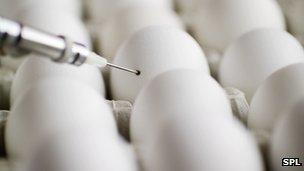How the seasonal flu jab is made
- Published

Hens' eggs are injected with very small amounts of the flu virus
It sounds unlikely, but you can't make a flu vaccine without breaking a few eggs.
The only manufacturer of the flu jab in the UK is Novartis, based Liverpool - which makes 30 million of the jabs a year for the global market.
Chickens play a crucial role in the process.
Hens' eggs began to be used to grow the flu virus in the 1940's because they provided the right conditions and nutrients.
Five drug companies now manufacture the world's flu vaccines and 70 years later all of them use eggs to grow the vaccine.
The NHS buys nearly 16 million doses a year.
Mark Harrop, is in charge of quality control on the Novartis production line.
He said: "Twelve times a day we get a delivery of 12 trolleys full of eggs. Each trolley has 5,500 eggs, so half a million each day. They stay in a warm room which is kept at constant temperature of 20 degrees Celsius."
'Huge egg cutter'
When the eggs have come out of the warm storage room they are inoculated with a small amount of flu virus.
He added: "Each needle will go into an individual egg and inject it with 2 millilitres of flu virus. They then get taken into incubators for 72 hours.
"About 40 trolleys go into the incubators which are temperature and humidity controlled to 35 degrees Celsius and the virus inside will grow.
"When the eggs come out of incubation they go into the harvest area where we use a huge egg cutter to take the top of the shell off.
"The blade runs across the top and a probe will suck out the allantoic fluid, the liquid near the edge of the shell, and that is effectively a version of the flu virus. We start this process at 6am in the morning and it continues for eight hours."
Hen security
The eggs are sourced from special farms based in the UK, where tight biosecurity controls and immunisations guard against diseases which might damage egg quality.
The vaccine manufacturing cycle goes on all year round. When labs have completed their orders for the Northern Hemisphere attentions are turned to the Southern.
Currently, production at the Merseyside Novartis labs is focusing on a strain known as the 8 California.
The vaccine is made-up of three different types of flu virus and a different drug is made every year based on the strains scientists predict will be circulating.
Beverly Taylor, head of technology at the drug company, said: "We manufacture one strain at a time so we don't mix during the manufacture. We produce all strains individually and then blend them together to make the final vaccine."
Predicting strains
The World Health Organization (WHO) has a global network of 147 laboratories in 110 countries monitoring influenza outbreaks.
The data collected informs which strains should be vaccinated against for the next winter.
"Surveillance works all year round," said Dr. Wenqing Zhang from the WHO's department for influenza. "You always need to monitor the virus and how it evolves and generate data for the recommendations which will be coming in February - just a couple of months away."
The jab being dispensed by GPs this year protects against H1N1 - the strain which caused the swine flu pandemic in 2009, H3N2 which can infect birds and humans and a third element known as a B strain which was active in 2010.
Predicting the next winter's flu strains can be a challenge according to the director of immunology for the Department of Health, Prof David Salisbury.
He said: "Most times we make a reasonable prediction and the match is good but not every time, sometimes viruses mutate and the vaccine isn't perfect.
"Over 10 years there will be times when the match isn't good and the vaccine won't be efficacious. When that happens there are cases that might otherwise have been prevented.
"It is to a degree a gamble because it's based on prediction."
Dr. Zhang from the World's Health Organization's department for influenza said: "Based on surveillance so far the viruses predicted in February are very much a match for the current viruses in the Northern Hemisphere."
- Published25 July 2012
- Published7 January 2011
- Published21 June 2012